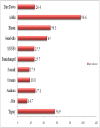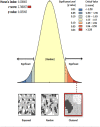Individual and community-level determinants, and spatial distribution of institutional delivery in Ethiopia, 2016: Spatial and multilevel analysis
- PMID: 33180845
- PMCID: PMC7660564
- DOI: 10.1371/journal.pone.0242242
Individual and community-level determinants, and spatial distribution of institutional delivery in Ethiopia, 2016: Spatial and multilevel analysis
Abstract
Background: Institutional delivery is an important indicator in monitoring the progress towards Sustainable Development Goal 3.1 to reduce the global maternal mortality ratio to less than 70 per 100,000 live births. Despite the international focus on reducing maternal mortality, progress has been low, particularly in Sub-Saharan Africa (SSA), with more than 295,000 mothers still dying during pregnancy and childbirth every year. Institutional delivery has been varied across and within the country. Therefore, this study aimed to investigate the individual and community level determinants, and spatial distribution of institutional delivery in Ethiopia.
Methods: A secondary data analysis was done based on the 2016 Ethiopian Demographic and Health Survey (EDHS) data. A total weighted sample of 11,022 women was included in this study. For spatial analysis, ArcGIS version 10.6 statistical software was used to explore the spatial distribution of institutional delivery, and SaTScan version 9.6 software was used to identify significant hotspot areas of institutional delivery. For the determinants, a multilevel binary logistic regression analysis was fitted to take to account the hierarchical nature of EDHS data. The Intra-class Correlation Coefficient (ICC), Median Odds Ratio (MOR), Proportional Change in Variance (PCV), and deviance (-2LL) were used for model comparison and for checking model fitness. Variables with p-values<0.2 in the bi-variable analysis were fitted in the multivariable multilevel model. Adjusted Odds Ratio (AOR) with a 95% Confidence Interval (CI) were used to declare significant determinant of institutional delivery.
Results: The spatial analysis showed that the spatial distribution of institutional delivery was significantly varied across the country [global Moran's I = 0.04 (p<0.05)]. The SaTScan analysis identified significant hotspot areas of poor institutional delivery in Harari, south Oromia and most parts of Somali regions. In the multivariable multilevel analysis; having 2-4 births (AOR = 0.48; 95% CI: 0.34-0.68) and >4 births (AOR = 0.48; 95% CI: 0.32-0.74), preceding birth interval ≥ 48 months (AOR = 1.51; 95% CI: 1.03-2.20), being poorer (AOR = 1.59; 95% CI: 1.10-2.30) and richest wealth status (AOR = 2.44; 95% CI: 1.54-3.87), having primary education (AOR = 1.47; 95% CI: 1.16-1.87), secondary and higher education (AOR = 3.44; 95% CI: 2.19-5.42), having 1-3 ANC visits (AOR = 3.88; 95% CI: 2.77-5.43) and >4 ANC visits (AOR = 6.53; 95% CI: 4.69-9.10) were significant individual-level determinants of institutional delivery while being living in Addis Ababa city (AOR = 3.13; 95% CI: 1.77-5.55), higher community media exposure (AOR = 2.01; 95% CI: 1.44-2.79) and being living in urban area (AOR = 4.70; 95% CI: 2.70-8.01) were significant community-level determinants of institutional delivery.
Conclusions: Institutional delivery was low in Ethiopia. The spatial distribution of institutional delivery was significantly varied across the country. Residence, region, maternal education, wealth status, ANC visit, preceding birth interval, and community media exposure were found to be significant determinants of institutional delivery. Therefore, public health interventions should be designed in the hotspot areas where institutional delivery was low to reduce maternal and newborn mortality by enhancing maternal education, ANC visit, and community media exposure.
Conflict of interest statement
The authors have declared that no competing interests exist.
Figures






Similar articles
-
Complete basic childhood vaccination and associated factors among children aged 12-23 months in East Africa: a multilevel analysis of recent demographic and health surveys.BMC Public Health. 2020 Dec 1;20(1):1837. doi: 10.1186/s12889-020-09965-y. BMC Public Health. 2020. PMID: 33256701 Free PMC article.
-
Spatial distribution and determinants of abortion among reproductive age women in Ethiopia, evidence from Ethiopian Demographic and Health Survey 2016 data: Spatial and mixed-effect analysis.PLoS One. 2020 Jun 29;15(6):e0235382. doi: 10.1371/journal.pone.0235382. eCollection 2020. PLoS One. 2020. PMID: 32598398 Free PMC article.
-
Spatial distribution and determinants of intimate partner violence among reproductive-age women in Ethiopia: Spatial and Multilevel analysis.BMC Womens Health. 2021 Feb 25;21(1):81. doi: 10.1186/s12905-021-01218-3. BMC Womens Health. 2021. PMID: 33632206 Free PMC article.
-
Institutional delivery service utilization and associated factors in Ethiopia: a systematic review and META-analysis.BMC Pregnancy Childbirth. 2020 Jun 15;20(1):364. doi: 10.1186/s12884-020-03032-5. BMC Pregnancy Childbirth. 2020. PMID: 32539698 Free PMC article.
-
Applied nutritional investigation spatial variation and determinants of stunting among children aged less than 5 y in Ethiopia: A spatial and multilevel analysis of Ethiopian Demographic and Health Survey 2019.Nutrition. 2022 Nov-Dec;103-104:111786. doi: 10.1016/j.nut.2022.111786. Epub 2022 Jul 1. Nutrition. 2022. PMID: 35970098 Review.
Cited by
-
Individual and community-level determinants and spatial distribution of prenatal HIV test uptake in Ethiopia: Spatial and multilevel analysis.Front Public Health. 2023 Feb 21;11:962539. doi: 10.3389/fpubh.2023.962539. eCollection 2023. Front Public Health. 2023. PMID: 36895690 Free PMC article.
-
Prevalence and determinants of post-neonatal mortality in East Africa: a multilevel analysis of the recent demographic and health survey.Front Pediatr. 2025 Jan 23;13:1380913. doi: 10.3389/fped.2025.1380913. eCollection 2025. Front Pediatr. 2025. PMID: 39917337 Free PMC article.
-
Minimum acceptable diet use and its associated factors among children aged 6-23 in Ghana: a mixed effect analysis using Ghana Demographic and Health Survey.Front Public Health. 2024 Sep 4;12:1402909. doi: 10.3389/fpubh.2024.1402909. eCollection 2024. Front Public Health. 2024. PMID: 39296848 Free PMC article.
-
Determinants of Utilization of Institutional Delivery Services in Zambia: An Analytical Cross-Sectional Study.Int J Environ Res Public Health. 2022 Mar 7;19(5):3144. doi: 10.3390/ijerph19053144. Int J Environ Res Public Health. 2022. PMID: 35270836 Free PMC article.
-
Women's health service access and associated factors in Ethiopia: application of geographical information system and multilevel analysis.BMJ Health Care Inform. 2023 Apr;30(1):e100720. doi: 10.1136/bmjhci-2022-100720. BMJ Health Care Inform. 2023. PMID: 37116949 Free PMC article.
References
-
- MAKU17 OE, OGWUMIKE FO, SANGOSANYA19 AO: Sub-Saharan Africa (SSA) and the millenium development goals (MDGs): Performance and strategic options. MILLENNIUM DEVELOPMENT GOALS (MDGS) AS INSTRUMENTS FOR DEVELOPMENT IN AFRICA 2014:305.
MeSH terms
LinkOut - more resources
Full Text Sources
Medical
Research Materials

